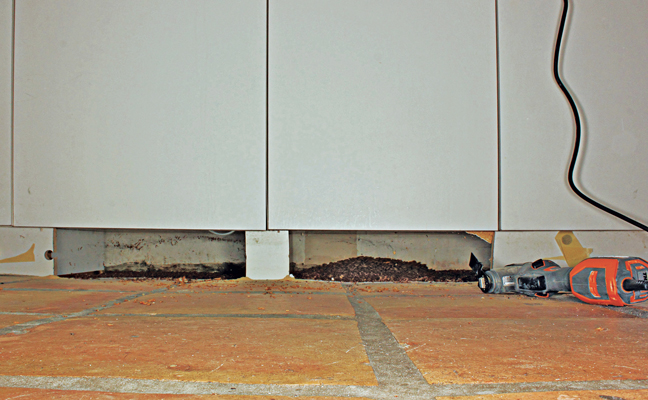(Editor’s Note: Read “Kitchen secrets, Part I: Vinegar flies,” here.)
- Stored product pests in the kitchen may be living in secret places.
- The mice may be gone, but have they left a time bomb of future pests?

Removing a cabinet kickboard can reveal extensive pet food debris, aka a food source for mice and stored product pests. PHOTO: MARK VANDERWERP
The kitchen seems to be everybody’s favorite room, and why should it be? It has secret compartments, hidden treasures (kind of), and betrayal. Among the common pests of homes are house mice (Mus musculus) and stored product pests (SPP). Let’s uncover some of their kitchen secrets.
They may be flour beetles (Tribolium spp.), drugstore beetles (Stegobium paniceum), or any number of other species, but when they’re showing up in numbers in a clean kitchen with no apparent source, one of your first questions to the customer should be, “Have you ever had mice?”
One of the obsessive mouse’s behaviors is, upon finding a rich supply of food, to carry it off piece by piece and store it in a hiding place. A big day in the life of a pest management professional (PMP) is the first time he or she tracks a beetle infestation back to pounds and pounds of dry dog food stashed in the space under a kitchen cabinet. It’s a mouse hoard!
It may also represent the life’s work (quite literally) of a mouse long gone. Dog food can sit for years, waiting to be found by the beetles.
While it starts slow, over the months and years the beetle population builds until it no longer can be ignored. You can look into these secret compartments with a borescope, or you may be able to drill a hole in a hidden section of the kickboard to peer inside.
DIY REPERCUSSIONS
Another aspect of mouse infestations gone by are the do-it-yourself (DIY) attempts to eliminate them. When a box of consumer mouse bait is put out by current, or even previous homeowners, it is often left in place, forgotten, or both. Like dog food, the mouse bait can sit for years until beetles or moths find it. The DIY pest control effort then becomes the source of the next infestation. Talk about betrayal! Consumer mouse bait boxes from decades ago are found regularly as they are transformed into a heaving mass of beetles.
When looking for SPP, the products they are infesting may not have been stored by the homeowner. Always ask about a history of mouse infestation. Keep in mind that the homeowners might never have seen any. The mice may have come and gone without notice, and the mouse problem may have originated from the previous owners.
On a final note, keep track of any rodenticide you may have put out. It’s nothing but embarrassing when your bait becomes the source of a SPP infestation.
You can reach Mark Sheperdigian, BCE, vice president of technical services, Rose Pest Solutions, Troy, Mich., at shep@rosepest.com.
Leave A Comment